 |
Early Crocuses |
| Home Recommend This Site To A Friend |
|
by Sandy Leven. Crocus tommasinianus - - A praiseworthy bulb Crocuses are excellent bulbs for giving colour to the rock garden in early spring. In many species there are several flowers in each corm and the individual flowers bloom over a period rather than all appearing at once. Therefore if the first flowers are open during a period of inclement weather and are spoilt or damaged the subsequent flowers can be pollinated and the corm will set seed. In the open garden Crocus tommasinianus is my favourite. To my mind its 'bad name' for seeding itself all over the garden is ill deserved. It is decried as invasive and gardeners are warned against planting it. My garden soil is heavy clay over layers of sandstone. The clay demands constant enrichment with humus to make it workable. Over the years my rock garden areas have had tons of humus and grit added. Crocus tommasinianus has not seeded itself widely beyond the area in which it was planted. If you have a cold heavy clay soil then I encourage you to grow this magnificent bulb. If you have a rich well drained loam then ask someone else. Crocus tommasinianus mixed in garden Because of its early flowering the blooms are often weather damaged. Although perfectly hardy these crocuses do not like to be battered by the rains and sleet of February and March. They appreciate some shelter from a rock or low wall. They look good in crevices. Mine grow on a west-facing bank covered with a deep layer of gravel. However moss grows over the surface during winter. From a nucleus of a few bulbs they have seeded into a diffuse colony. The resultant seedlings are very varied in colour, from very pale lilac to rich purple with various intermediate colours and even bicoloured flowers. I like them all but particularly enjoy the bicoloured flowers before they open. Some have a buff coloured reverse on the petals. I have selected various flowers from the picture in the garden and grouped the flowers from left to right according to deepness of flower colour. The range is quite amazing. 
In recent years my Crocus tommasinianus have suffered by being consumed by pheasants. The voracious birds eat the emerging flowers before I can enjoy them in some years. Cynics will say this is why they do not seed around and certainly flowers eaten by pheasants never set seed! Once individual seedlings start to bulk up nice clumps decorate the rock garden with large purple stars. I never tire of the variation in flower colour and to a lesser extent flower shape. When the colony is at its peak flowering some flowers are passed and collapsed while others are still in bud. The picture below shows all these stages. 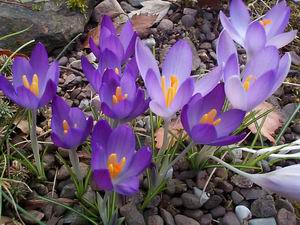
I grow some special forms of Crocus tommasinianus in a cold frame. The glass protects the flowers from the weather but also heats up the pots with the result that even in frames with the lids raised these Tommys flower to weeks or more before those in the garden. 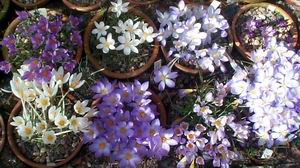
Crocuses have a tendency to flop in a warm frame. The heat seems to force the flowers a bit too much with the result that their tubes are unable to support the flower bowl and they fall over. A flopped crocus is not a pretty crocus. Every year these crocus in pots flower at the time of the Dunblane Early Bulb Display i.e. the 3rd Saturday in February. Lyn Bezzant found a special clump of Crocus tommasinianus in her Monievreckie garden. She named the form 'Lyn's Pink' and it is quite distinct being a rich pink / purple colour, always much more rosy the any others which I grow. The flowers start deeper in colour and lighten a little over a few days. 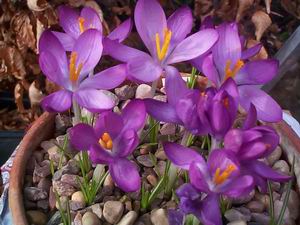
I grow a white flowered clone whose flowers are more bowl shaped than my other clones of Crocus tommasinianus. Its flowers are pristine white with no hint of yellow in their throat. Like all the other clones the inside of the petals has a glistening sheen, presumably to focus heat on the stigma. All clones have orange stigmas and stamens. 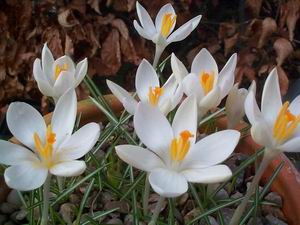
I was fortunate at one of our bulb exchanges to get a few corms of a clone of Crocus tommasinianus with the number VMH 962. This proved o be a fabulous plant. Its petals remind me of ice. They are bluer than others but what makes the flowers extraordinary is that they shade from very pale in the centre to be much deeper at the tips of the petals. The shading is gradual but quite definite. A clump in full flower is beautiful beyond description. Crocus vernus in its Easter form which used to be known as Crocus heuffelianus has dark tips to its petals. This is quite different from the VMH form of Crocus tommasinianus. In the former the shade distinction is much more abrupt. C.vernus also has much narrower petals, which in my forms are never bowl shaped because they tend to be separated. The stigmas are also different, being longer in C.vernus I wonder of the VMH Crocus tommasinianus might be a hybrid. 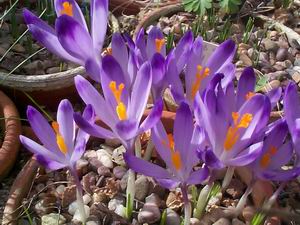 Crocus vernus eastern 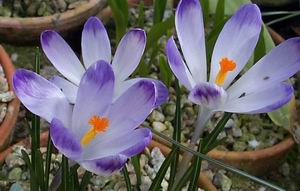 Crocus vernus Whichever you decide to grow Crocus tommasinianus is a beautiful bulb and I strongly recommend it to you. 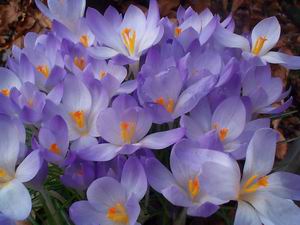
|